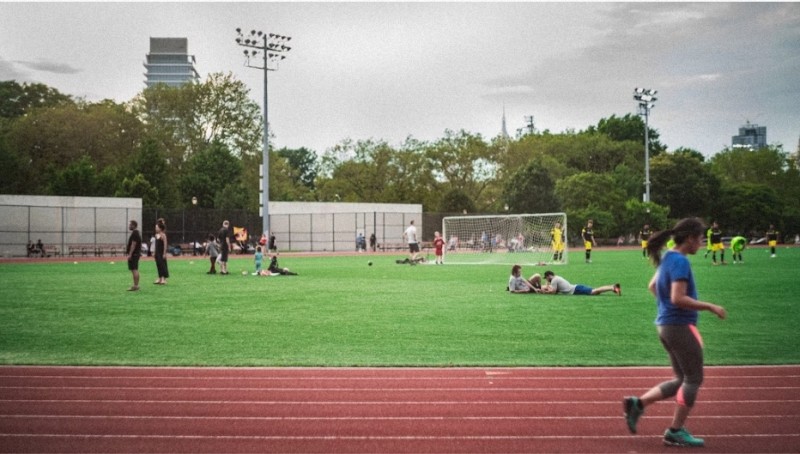– Mashum Mollah

The public health focus brought on by the pandemic has increased the focus on the role of physical education in school curriculum.
Of late, most parents, while looking for a CBSE school in Gurgaon, place great importance on physical activities and sports education at the school.
Physical education educators play a key role in shaping student development beyond physical fitness and motor skills.
Physical activity can help kids grow strong bones and muscles, lower their risk of obesity and chronic illnesses, and have more energy.
Physical activity can also assist students’ physical health and general well-being. Furthermore, sports education may allow children to develop vital life skills like teamwork, leadership, and communication.
When teachers value good sportsmanship, students learn to enjoy the game, respect their opponents, and appreciate the efforts of both teams.
Regardless of the age of the students, sportsmanship may be promoted in any physical education lesson. It extends beyond professional sports.
Understanding the Importance Of Sports Education
Listed below are some of the major reasons why implementing physical activities in schools is extremely important.
1. Promotes Respect Among Students
Respect is essential to good sportsmanship because it involves acknowledging the skills and efforts of others, following the rules, and playing fair without cheating or intentionally hurting others.
This includes respecting the rules of the game and the decisions of teachers or on-ice officials.
Good sportsmanship demonstrates patience, understanding, and recognition that people have different ability levels and that making mistakes is part of learning.
This includes acknowledging opponents’ efforts and congratulating them on their successes, showing humility in victories and mercy in defeats, and showing respect to teammates and opponents on and off the field.
An environment of mutual respect increases the enjoyment and enjoyment of the game and leads to a better sporting experience for all.
It also encourages teamwork and collaboration as players learn to work together towards a common goal.
2. Helps Inculcate Leadership Skills
Developing leadership skills is one of the most important reasons parents, teachers, and organisations should promote sports education in schools.
Respect is essential to good sportsmanship because it involves acknowledging the skills and efforts of others, following the rules, and playing fair without cheating or intentionally hurting others.
This includes respecting the rules of the game and the decisions of teachers or on-ice officials.
Good sportsmanship demonstrates patience, understanding, and recognition that people have different ability levels and that making mistakes is part of learning.
This includes acknowledging opponents’ efforts and congratulating them on their successes, showing humility in victories and mercy in defeats, and showing respect to teammates and opponents on and off the field.
An environment of mutual respect increases the enjoyment and enjoyment of the game and leads to a better sporting experience for all.
It also encourages teamwork and collaboration as players learn to work together towards a common goal.
3. Helps Students Learn How To Take Instructions
Physical education classes require order and discipline to ensure safety and create a learner-friendly environment.
Teachers should set clear rules and outcomes and enforce them to maintain a positive and productive atmosphere.
Students must understand that rules and instructions exist for their safety and ensure the game is fun and fair for all.
Good sportsmanship, respect for authority, and teamwork are prerequisites for good sportsmanship; students who demonstrate it are more likely to succeed in sports and life.
Through sports, children learn the importance of teamwork and communication, provide healthy opportunities for physical activity, promote a healthy lifestyle, and reduce the risk of obesity.
The ability to take instructions from teachers, coaches, and fellow team members helps children develop important life skills such as:
- Collaborative work.
- Relying on each other’s strengths.
- Strengthening communication skills.
- The ability to resolve conflicts in a healthy way.
4. Helps Young Students Grow Emotionally
Through sports, children learn to control and channel negative emotions into positive ones. It can lead not only to higher academic performance but also to higher self-esteem and better social interaction.
Studies show that physical activity stimulates feel-good chemicals in the brain that have positive health effects.
Regular physical activity has been found to reduce anxiety and depression symptoms and improve overall mental health and well-being by promoting better sleep patterns and reducing stress levels.
Additionally, through sports, children learn valuable life skills such as teamwork, perseverance, and discipline that can help them succeed in other areas of life.
Encouraging children to exercise has physical, emotional, and social benefits that contribute to their overall well-being.
5. Helps Establish The Sportsman Spirit Right From Young Age
It’s important to value the spirit of the game over absolute victory when playing fairly. No of the outcome, you must respect and treat your adversaries with decency.
This entails taking accountability for your deeds and refraining from using strategies antithetical to fair play.
It is more fulfilling when victory is attained with sincere effort and provides a positive example for others to follow. Yet losing is also a part of the game, and it should be handled politely.
Teachers should stress the value of fair play and the repercussions of bad sportsmanship. Fair play encourages sportsmanship and respect among competitors, resulting in a favorable environment that is pleasurable for all parties.
It also fosters positive character attributes that transcend athletics, such as honesty, responsibility, and humility.
6. Helps Nurture Patience And Perseverance In Young Students
Athletes acquire the tenacity required to push beyond setbacks and pursue excellence. This resiliency may be used in various facets of life in addition to sports.
Patience in sports education is essential for success because it enables players to grow from their setbacks and keep trying to succeed.
Sports also instill in people the value of cooperation and teamwork, which can increase achievement.
Athletes must follow stringent training regimens and restrictions both on and off the pitch, which can help players develop a feeling of discipline and devotion.
Athletes must efficiently interact with their teammates throughout training and games. Therefore, playing sports also fosters teamwork and communication skills.
How To Implement Physical Activities In Schools
Physical education is crucial to student learning, especially for younger students. Being a teacher, parent, or student may all help.
All children should participate in sports, yoga, informal and formal games, free play, and other activities to help them develop their physical and psychological well-being since regular physical exercise enhances one’s health and well-being.
Games and yoga in sports education will improve various skills, including the following:
- Endurance,
- Fine and large motor skills.
- Dexterity.
- Self-awareness.
- Control.
- Coordination in group games.
Right from school admission in Gurgaon, organizations must portray sports as an important aspect of school life.
Not simply for preventing obesity and other weight-related problems but also for the development of young children, schools should provide playtime and physical education.
Teachers must address this issue by including physical exercise in lesson plans, encouraging students to play team sports, introducing individual activities into the curriculum, requesting that parents remember physical education at home, and promoting playtime in the classroom.
For physical education, low-cost, high-reward resources are available that align with national and state requirements.
Teachers can also use digital tools, music, or task cards to create new lesson plans and curricula. Teachers may develop dozens of productive and healthy instructional programmes with little research and money.
Also read:
Career in sports on your mind? These schools can put you on track


















